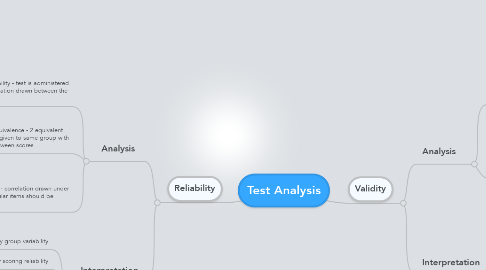
1. Validity
1.1. Analysis
1.1.1. Yields non-numerical validity evidence
1.1.1.1. Content Validity - compares test questions to learning objectives
1.1.2. Yields numerical value for validity evidence
1.1.2.1. Criterion-Related Validity - compares test scores to external criterion or standard
1.1.2.1.1. Concurrent - test scores for correlation collected at same time
1.1.2.1.2. Predictive - period of time passes between test score collection
1.1.2.2. Construct Validity - compares correspondence of of test results to scores on other variables using predictions based on established theory or rationale
1.2. Interpretation
1.2.1. dependent on validity coefficient & test purpose
1.2.2. affected by group variability
1.2.3. correlation considers reliability of criterion or standard
2. Reliability
2.1. Analysis
2.1.1. Test-Retest/Stability - test is administered twice with correlation drawn between the scores
2.1.1.1. scores affected by memory & experience of test subjects
2.1.1.2. requires very short time between tests
2.1.2. Alternate Forms/Equivalence - 2 equivalent forms of same test given to same group with correlatin drawn between scores
2.1.2.1. eliminates contamination from memory & prior experience
2.1.2.2. difficult to create 2 good tests
2.1.3. Internal Consistency - correlation drawn under assumption that similar items should be answered correctly
2.1.3.1. Split-Half - single test split into halves with correlation drawn from scores on each half
2.1.3.2. Item Total - measures commonality of test items in one form of test to those in alternate form
2.2. Interpretation
2.2.1. affected by group variability
2.2.2. affected by scoring reliability
2.2.3. affected by test length
2.2.4. affected by individual item difficulty
